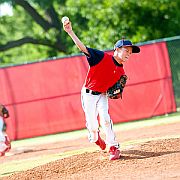- Navigating Your Midlife Crisis: Embracing New Possibilities
- City Raccoons Showing Signs of Domestication
- Mapping the Exposome: Science Broadens Focus to Environmental Disease Triggers
- One Week Less on Social Media Linked to Better Mental Health
- Your Brain Changes in Stages as You Age, Study Finds
- Some Suicide Victims Show No Typical Warning Signs, Study Finds
- ByHeart Formula Faces Lawsuits After Babies Sickened With Botulism
- Switch to Vegan Diet Could Cut Your Greenhouse Gas Emissions in Half
- Regular Bedtime Does Wonders for Blood Pressure
- Dining Alone Could Mean Worse Nutrition for Seniors
Faster, Taller Youth League Pitchers May Face Greater Risk of Injury


Faster pitching, being taller and playing on multiple baseball teams are linked to a higher risk of pitching-related injuries in youth baseball players, a new study found.
“Playing for multiple teams increases the number of pitches that a player throws and the likelihood that a pitcher is throwing through fatigue,” said study lead author Dr. Peter Chalmers, an orthopedic resident at Rush University Medical Center in Chicago. “Multiple studies have shown fatigue to be a major risk factor for injury.”
Previous research has found that too many young baseball players are playing through pain from pitching injuries, and that parents are unaware of guidelines for reducing risk of injury.
To learn more about the risk factors linked to injury, Chalmers and fellow researchers gathered pitching histories and analyzed high-speed videos of 420 youth pitchers in Chicago. Nearly one-third of the teenage and younger pitchers had a previous pitching-related injury.
The investigators found that an extra 8.6 inches of height or an increase of 17 miles per hour in pitching velocity doubled a young pitcher’s odds of injury. Playing for more than one team also boosted the risk of injury by 61 percent.
Chalmers cautioned that these findings — presented this week at a meeting of the American Orthopaedic Society for Sports Medicine in Las Vegas — don’t prove these factors cause the injuries. The risk factors are only associated with injuries, but there are several reasons that may explain the link.
“Taller players can have longer strides, which allow them to generate more force that travels through the shoulder and elbow,” Chalmers said. “Higher velocity pitches have been demonstrated to increase stress on the shoulder and elbow, which is why they may increase the risk of injury.”
Past research has also shown faster pitching can predict future risk of injury, Chalmers said.
Other factors that can contribute to fatigue and overuse, and then lead to injury, are year-round baseball, throwing too many pitches in a single game and throwing too many innings in a game or season, said Dr. Christopher Ahmad, the New York Yankees’ head team physician and professor of orthopedic surgery at Columbia University Medical Center in New York City.
“Prior biomechanical research and epidemiology have shown that throwing harder and faster increases stresses especially to the inside aspect of the elbow,” Ahmad said. Extra stress from high-velocity throwing can ultimately injure a player’s ulnar collateral ligament, requiring a player to consider “Tommy John surgery,” in which a surgeon replaces the ligament in the elbow with one from another part of the body.
“Many parents and players have a cavalier attitude toward elbow injury,” Ahmad said. “Many of these athletes believe having surgery can help them improve their performance. That is not the case. Surgery does not enhance performance. Surgery has the capacity to allow athletes to continue their development.”
Ahmad recommended monitoring a player’s fatigue and possibly taking time off during the season as needed. He also recommended avoiding playing on multiple teams, too much training that involves hard throwing, and showcases where young pitchers feel pressure to throw as hard as they can to impress coaches and scouts.
Dr. Paul Saluan, director of pediatric and adolescent sports medicine at the Cleveland Clinic, warned that ignoring guidelines or a prior injury, which can increase the risk of future injury, could hurt players down the line.
“A fair number of these players may end up with injuries that can have lifelong consequences, which can decrease velocity, accuracy or both,” Saluan said. “This effectively decreases their chances at going to the next level as a pitcher.”
Parents should follow age-related guidelines on the maximum number of throws pitchers should make and the rest needed between pitching stints, Saluan said. If a pitcher begins to experience pain, address it immediately to reduce the risk of injury, even if that means sitting out a few days.
“Kids need to learn proper mechanics of throwing at an early age. Once they have learned how to throw safely, they need to play more and train less,” Saluan said. “They also need to know that too much, too soon may create lifelong problems that could take them out of the game they love.”
Research presented at meetings should be considered preliminary until published in a peer-reviewed medical journal.
More information
The Pitch Smart program developed by Major League Baseball offers pitching guidelines.
Source: HealthDay
Copyright © 2025 HealthDay. All rights reserved.










